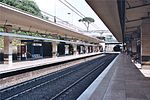Pyramid of Cestius
12 BC1st-century BC inscriptionsAncient Roman tombs and cemeteries in RomeBuildings and structures completed in the 1st century BCLatin inscriptions ... and 3 more
Pyramids in EuropeRome R. XX TestaccioTourist attractions in Rome

The pyramid of Cestius (in Italian, Piramide di Caio Cestio or Piramide Cestia) is a Roman Era pyramid in Rome, Italy, near the Porta San Paolo and the Protestant Cemetery. It was built as a tomb for Gaius Cestius, a member of the Epulones religious corporation. It stands at a fork between two ancient roads, the Via Ostiensis and another road that ran west to the Tiber along the approximate line of the modern Via Marmorata. Due to its incorporation into the city's fortifications, it is today one of the best-preserved ancient buildings in Rome.
Excerpt from the Wikipedia article Pyramid of Cestius (License: CC BY-SA 3.0, Authors, Images).Pyramid of Cestius
Via Raffaele Persichetti, Rome Municipio Roma I
Geographical coordinates (GPS) Address Website External links Nearby Places Show on map
Geographical coordinates (GPS)
| Latitude | Longitude |
|---|---|
| N 41.876388888889 ° | E 12.480833333333 ° |
Address
Piramide di Caio Cestio
Via Raffaele Persichetti
00153 Rome, Municipio Roma I
Lazio, Italy
Open on Google Maps











